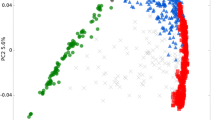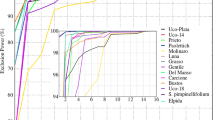Abstract
Lycopersicon esculentum var. cerasiforme and closely allied biotypes of the species are widely distributed as wild or feral forms in the eastern Andean foothills of the Ceja de la Montaña, Perú and equivalent areas of Bolivia and Ecuador. As assayed by allozymic variation at 20 loci and five monogenic morphological loci, the extent of their genetic variation, although relatively low, is sufficient to provide clues as to their hybridity, phylogeny, and possible affiliations with cultivated tomatoes. According to interviews with agronomists, growers, and aboriginals, this entity is seldom cultivated and is not considered indigenous. The level of genetic variation is higher in the central San Martín-Ayacucho region and decreases northward and southward. Tarapoto (Bajo Mayo, Departamento San Martín) is a district of high variability for fruit shape, size, and color, although within the range of allozyme variability for the central region. Allele substitution for a few genes could account for this variation, which grades continuously to the small fruits of var. cerasiforme. Introgression between the latter and introduced cultivars could account for this complex. Rather high levels of cross-pollination estimated for the Bajo Mayo (and other parts of the central area) are compatible with this hypothesis. The presence of several variant alleles in the central region and throughout the coastal populations of var. cerasiforme and ofL. pimpinellifolium suggests an affiliation between them, the latter presumably ancestral. According to the total evidence, the eastern Andes seems to be a secondary center of variability, probably not the primary site of domestication of the cultivated tomato.
Similar content being viewed by others
Literature Cited
Durante, C. 1585. Herbario Nuovo. Rome.
Jenkins, J. A. 1948. The origin of the cultivated tomato. Econ. Bot.2:379–392.
Matthiolus, P. A. 1544. Di Pedacio Dioscoride Anazarbeo libri cinque della historia, et materia medicinale trodotte in lingua volgare Italiana. Venice.
Rick, C. M. 1978. Tomato. Pages 268–273in N. Simmonds, ed., Evolution of crop plants. Longman, London.
-. 1983a. Evolution of mating systems: evidence from allozyme variation. Proc. XV Int. Congr. Genetics (New Delhi), p. 216–221.
— 1983b. Tomato. Pages 147–165in S. D. Tanksley and T. J. Orton, eds., Isozymes in plant genetics and breeding, B. Elsevier, Amsterdam.
— and J. F. Fobes. 1975. Allozyme variation in the cultivated tomato and closely related species. Bull. Torrey Bot. Club 102:376–386.
—, —, and M. Holle. 1977. Genetic variation inLycopersicon pimpinellifolium: evidence of evolutionary change in mating systems. Plant Syst. Evol.127:139–170.
Author information
Authors and Affiliations
Rights and permissions
About this article
Cite this article
Rick, C.M., Holle, M. Andean lycopersicon esculentum var. cerasiforme: genetic variation and its evolutionary significance. Econ Bot 44 (Suppl 3), 69–78 (1990). https://doi.org/10.1007/BF02860476
Issue Date:
DOI: https://doi.org/10.1007/BF02860476




